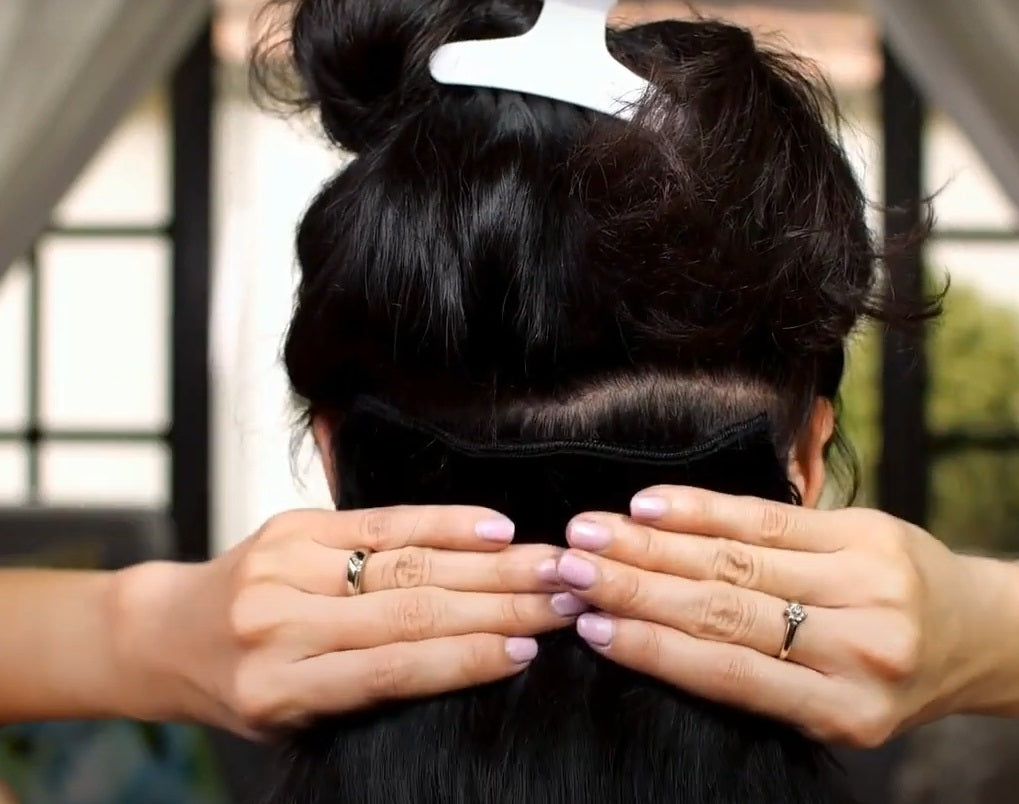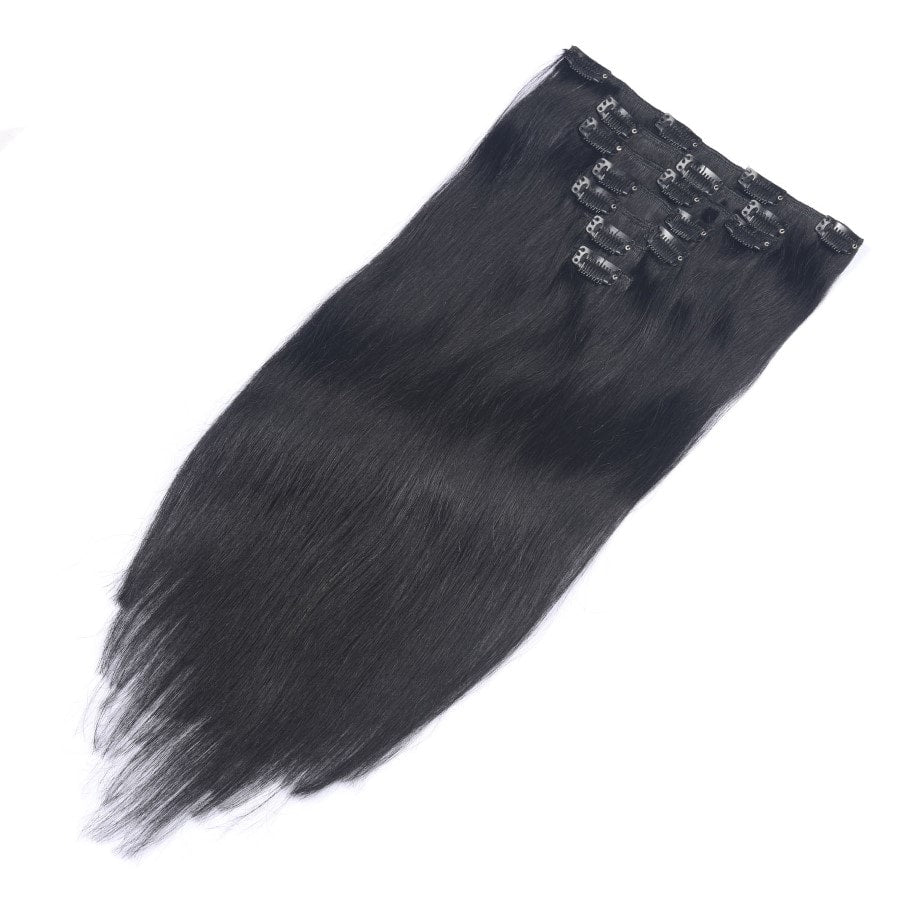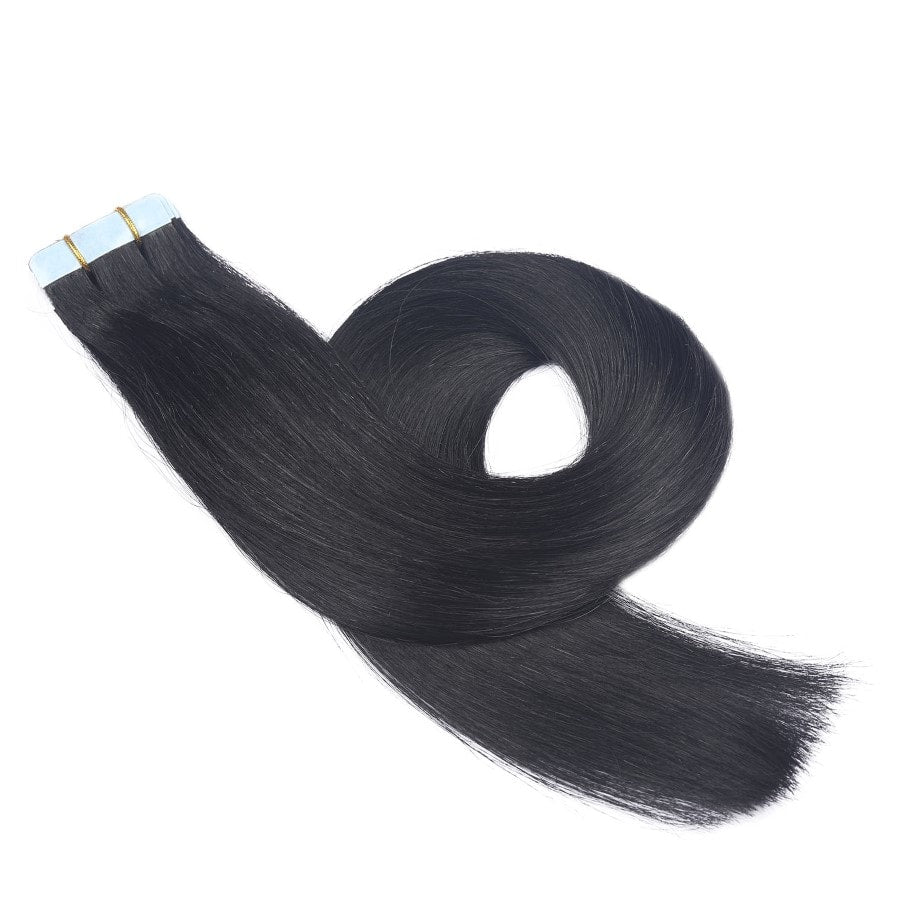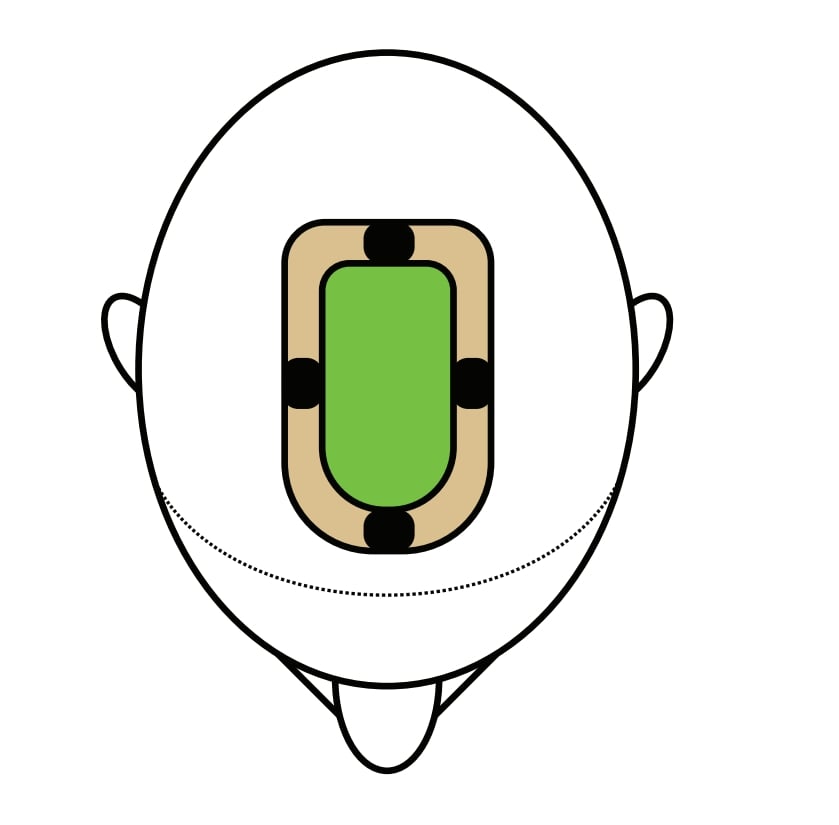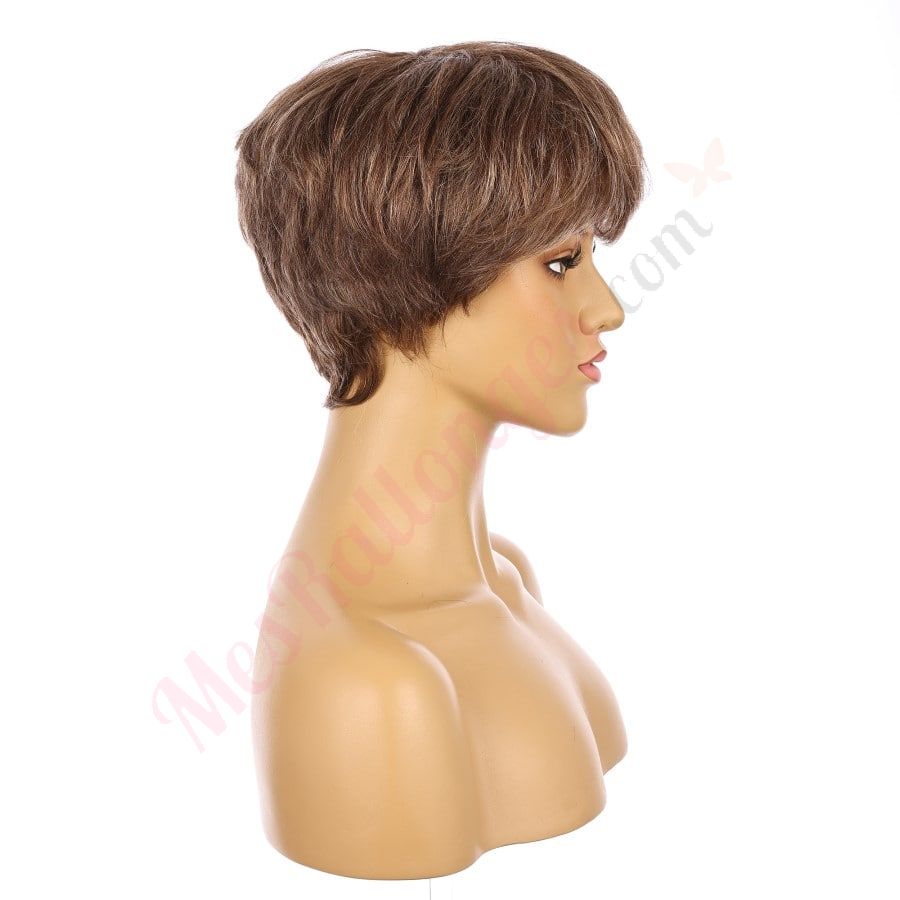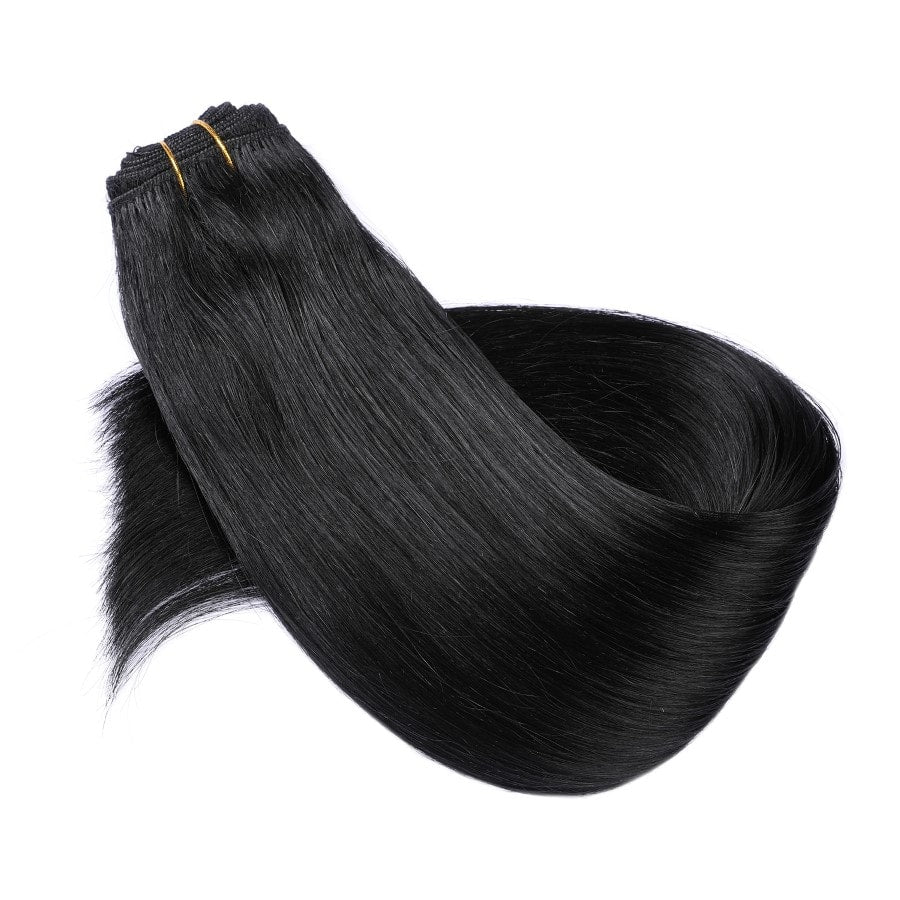Êtes-vous fatigué de faire face à extensions de cheveux à clips qui ne tiennent pas en place ? Nous sommes toutes passées par là, à lutter pour les maintenir en place tout au long de la journée. Que vous vous prépariez pour une soirée ou une journée normale, il est frustrant de voir vos extensions commencer à glisser.
La bonne nouvelle est que vous pouvez maintenir vos extensions de cheveux en place avec quelques astuces simples. Des techniques d'installation appropriées aux conseils d'entretien quotidien, nous vous guiderons à travers tout ce que vous devez savoir. Avec le bon savoir-faire, vous pouvez profiter de cheveux somptueux et volumineux sans vous soucier de votre clips-ins tomber.
Imaginez-vous marcher en toute confiance, sachant que vos extensions sont fermement en place et impeccables. Il est temps de prendre le contrôle et de vous assurer que vos cheveux sont parfaits tous les jours. Découvrons les meilleures façons d'empêcher ces extensions de glisser.
Principaux points à retenir
- Fixez vos clips avec des techniques d'installation appropriées
- L'entretien quotidien est essentiel pour éviter les glissades
- Choisissez les produits adaptés à votre type de cheveux
Comprendre les extensions à clips
Les extensions de cheveux à clips sont un moyen fantastique de ajouter du volume et de la longueur à nos cheveux. Ils sont temporaires, faciles à utiliser et peuvent être coiffés comme nos cheveux naturels.
Que sont les extensions à clips ?
Les extensions à clips sont des postiches que nous pouvons fixer sur nos cheveux naturels à l'aide de petites pinces sensibles à la pression. Ces extensions sont généralement fabriquées à partir de fibres synthétiques ou Cheveux Remy , qui sont des cheveux humains de haute qualité qui conservent la couche de cuticule naturelle.
Nous pouvons les trouver dans différentes longueurs et couleurs , nous permettant de les assortir parfaitement avec nos cheveux. Le principal avantage est qu'ils ne nécessitent aucune pose professionnelle ; nous pouvons facilement les mettre ou les enlever à la maison.
Conseils importants :
- Choisissez toujours une couleur qui se marie bien avec nos cheveux naturels.
- Assurez-vous que les clips sont bien fixés pour éviter tout glissement.
- Prenez soin des extensions comme nous le ferions de nos propres cheveux pour prolonger leur durée de vie.
Les avantages de choisir des clips
Les extensions à clips offrent plusieurs avantages ce qui les rend idéales pour celles d'entre nous qui cherchent à améliorer temporairement leur coiffure. Tout d'abord, elles sont très pratiques. Contrairement à d'autres types d'extensions qui peuvent nécessiter de la colle ou des outils spéciaux, celles-ci peuvent être appliquées rapidement.
Ils nous permettent de changer de coiffure pour des occasions spéciales ou pour un usage quotidien sans aucun engagement à long terme. Si nous voulons ajouter du volume et de la longueur pour une soirée, nous les attachons simplement et les retirons avant de nous coucher. Ils sont également moins dommageables pour nos cheveux naturels car il n'y a pas besoin de produits chimiques ou de chaleur lors de l'application.
Pourquoi nous aimons les clips :
- Flexibilité: Nous pouvons les supprimer quand nous le souhaitons.
- Confort: Ils sont légers et confortables à porter.
- Versatilité: Nous pouvons les coiffer comme nos cheveux naturels avec des outils et des produits.
Les clips nous offrent véritablement une option polyvalente et conviviale pour changer de coiffure quand nous le souhaitons.
Raisons courantes pour lesquelles les clips tombent
Nous avons tous connu cela : nous posons soigneusement nos extensions de cheveux à clips et elles glissent juste au moment où nous en avons besoin. Voici pourquoi cela peut se produire et ce que nous pouvons faire pour y remédier.
L'impact du type de cheveux sur la stabilité des clips
Le type de cheveux joue un rôle important dans la façon dont les extensions à clips restent en place. Pour celles d'entre nous qui ont les cheveux gras, les extensions peuvent rapidement devenir glissantes. Les cheveux fins posent également des problèmes car ils peuvent manquer de texture pour que les clips se fixent fermement. Crêpage aide à créer l'adhérence nécessaire pour maintenir les extensions. Si vous avez les cheveux bouclés ou ondulés, la texture naturelle de vos cheveux peut fournir un bon ancrage pour les clips, réduisant ainsi le glissement.
Comment l'accumulation de produit peut affecter vos extensions
L'accumulation de produits est un autre coupable Les clips tombent . Les produits coiffants, les huiles et les revitalisants s'accumulent sur nos cheveux naturels et sur les extensions elles-mêmes. Cette accumulation peut rendre les cheveux de plus en plus glissants. Nous devons nous assurer de se laver les cheveux régulièrement et utilisez un shampooing clarifiant pour éliminer les résidus. Garder nos extensions propres et exemptes d'accumulation est essentiel pour maintenir leur adhérence.
Le rôle de la texture et du volume des cheveux
La texture et le volume des cheveux sont essentiels pour que les extensions à clips restent en place. Les cheveux fins ou plats offrent moins de possibilités de fixation, ce qui facilite le glissement des extensions. ajouter du volume grâce au crêpage ou en utilisant des produits volumisants, nous pouvons fournir une meilleure base pour les extensions. À l'inverse, les personnes aux cheveux épais et volumineux ont plus de facilité à fixer les clips, car il y a plus de cheveux sur lesquels les clips peuvent s'accrocher.
Ajuster la texture de nos cheveux en fonction des besoins des clips aidera à les maintenir en place tout au long de la journée.
Techniques d'installation appropriées
Pose d'extensions à clips assure correctement qu'ils restent fermement en place et paraissent naturels . Discutons des étapes impliquant la préparation, la fixation et la création d'une base solide pour vos extensions.
Préparer vos cheveux naturels pour les extensions
Tout d’abord, nous devons préparer nos cheveux pour donner aux clips la meilleure chance de rester en place. Commencez avec des cheveux propres et secs. Les cheveux gras ou mouillés rendent les clips plus difficiles à tenir.
Utilisez un peigne à dents fines ou peigne à queue de rat pour séparer les sections où iront les extensions. Crêpage arrière ou taquinerie ces sections peuvent ajouter la texture nécessaire pour une adhérence plus ferme.
L'application d'un peu de shampoing sec ou d'un spray texturant peut également aider. Cela donne du grain à nos cheveux, ce qui permet aux pinces de rester plus facilement en place.
Fixation des clips pour une tenue maximale
Ensuite, concentrons-nous sur la fixation de nos clips. Commencez par ouvrir tous les clips de la rallonge. Appuyez sur les clips pour les ouvrir et les clipser sur les sections de cheveux crêpées.
Pour une meilleure tenue, assurez-vous de bien appuyer les clips contre la racine de vos cheveux naturels. Vérifiez chaque clip pour vous assurer qu'il est solidement fixé et qu'il ne semble pas lâche.
Si vous avez encore du mal à faire glisser les extensions, essayez de croiser deux épingles à cheveux juste en dessous de la section où l'extension sera fixée. Cela donne une couche de soutien supplémentaire.
Créer une base solide pour vos extensions
Pour créer une base solide, en particulier pour les extensions plus épaisses, pensez à créer une tresse africaine ou un base tressée où les clips seront fixés. Les tresses africaines peuvent fournir un point d'ancrage solide pour les extensions.
Séparez les cheveux horizontalement et faites une petite tresse ou une tresse africaine le long de cette section. Fixez l'extension directement sur cette tresse. Cette méthode fonctionne très bien pour types de cheveux fins ou glissants .
Alternativement, pour ceux d'entre nous qui préfèrent une option plus rapide, il suffit de sectionner et de peigner fermement la racine. peigne à dents fines sectionner les cheveux avant de les couper assure une coupe plus nette et plus soignée aspect naturel .
Bon coiffage ! Profitons de nos cheveux volumineux et luxuriants.
Conseils d'entretien et de coiffage quotidiens
Pour que nos extensions à clips restent belles et en place, nous devons nous concentrer sur un brossage approprié, l'utilisation des bons produits et le suivi de routines de soins capillaires spécifiques.
Techniques de brossage et de peignage
Nous devrions toujours utiliser un peigne à dents larges ou un spécial Brosse à extensions . Commencez par les pointes et remontez vers le haut pour éviter de tirer sur les racines. Il est important d'être doux pour éviter d'abîmer à la fois nos cheveux naturels et les extensions.
- Routine matinale : Peignez nos extensions le matin pour éliminer les nœuds causés par le sommeil.
- Avant le lavage : Démêlez les extensions avant le lavage pour éviter les nœuds.
- Routine nocturne : Brossez-les doucement avant de vous coucher.
Produits et pratiques de coiffage pour éviter les glissements
Utiliser les bons produits évite que nos extensions ne glissent. Optez pour sans alcool et sans sulfate shampoings et revitalisants. Ils aident à maintenir l'intégrité et la douceur de nos extensions. Shampoing sec c'est également un excellent produit pour garder nos cheveux propres et volumineux sans provoquer de glissement.
- Spray texturant : Un peu de spray texturant peut ajouter de l'adhérence à nos cheveux naturels, aidant ainsi les clips à rester bien en place.
- Crêpage arrière : Crêpez légèrement les racines où nous prévoyons de fixer les extensions pour créer un coussin pour une meilleure adhérence.
Routines de soins capillaires pour maintenir vos extensions en place
Suivez des routines de soins spécifiques pour garantir que nos extensions restent en place toute la journée. Ne dormez jamais avec des extensions mouillées et attachez toujours vos cheveux en un queue de cheval lâche ou tresse avant de se coucher. Une manipulation appropriée lors du lavage est également cruciale.
- Lavage: Utiliser eau tiède lors du lavage de nos extensions.
- Séchage: Laissez-les sécher à l’air libre lorsque cela est possible ; évitez la chaleur excessive pour prolonger leur durée de vie.
- Évitez les manipulations brutales : Manipulez-les avec précaution lors du brossage et du coiffage pour éviter qu'ils ne se détachent ou ne tombent.
Ces conseils nous aideront à entretenir et à coiffer nos extensions à clips en toute simplicité, en les gardant bien en place et en leur donnant une apparence fabuleuse toute la journée.
Choisir les bons produits d'extension de cheveux
La clé pour garder votre clip-in extensions qui tombent Il est essentiel de choisir les bons produits et de prêter attention aux détails clés tels que le type de cheveux, le poids et les produits d'entretien. Voyons ce que vous devez prendre en compte.
Distinguer les cheveux humains des extensions synthétiques
Tout d’abord, nous devons connaître la différence entre cheveux humains et Les extensions de cheveux synthétiques . Les extensions de cheveux humains sont fabriquées à partir de vrais cheveux humains, elles ont donc un aspect plus naturel et peuvent être coiffées avec des outils chauffants. Elles sont plus chères mais durent plus longtemps.
Les extensions synthétiques sont fabriquées à partir de fibres qui imitent les cheveux humains. Bien qu'elles soient moins chères, elles ne peuvent pas être coiffées à la chaleur et ne se mélangent pas aussi bien avec nos cheveux. cheveux naturels . Choisir le meilleur type de cheveux en fonction de notre style de vie et de notre budget est crucial. Personnellement, je pense extensions de cheveux humains valent l’investissement en raison de leur aspect naturel et de leur flexibilité de style.
L'importance du poids et de la longueur
Le poids et longueur Les extensions de cheveux jouent un rôle important dans leur maintien. Si nos extensions sont trop lourdes, elles peuvent tirer sur nos cheveux naturels, les faisant tomber ou les abîmer.
Il faut adapter le poids des extensions à l'épaisseur de nos cheveux. Par exemple, les personnes aux cheveux fins doivent opter pour des extensions plus légères, tandis que celles aux cheveux plus épais peuvent se contenter d'extensions plus lourdes.
Longueur est également important. Les extensions très longues peuvent paraître glamour, mais elles peuvent avoir plus tendance à glisser. Choisir une longueur qui complète nos cheveux et notre style de vie permet de tout maintenir en place.
Sélection de produits de soins capillaires de qualité
Utiliser le droit produits de soins capillaires gardera nos extensions à clips en parfait état. Shampoing clarifiant est excellent car il élimine l'accumulation de produits qui peuvent affaiblir la liaison entre nos cheveux et les extensions. Il est également essentiel d'éviter les produits contenant des sulfates, de l'alcool ou de l'huile, car ils peuvent décomposer les adhésifs.
Nous devrions opter pour produits capillaires doux qui nourrissent nos cheveux sans être trop agressifs. Il existe de nombreux marques de qualité Il existe des produits qui s'adressent à la fois aux cheveux naturels et aux extensions. Choisir les bons produits fera donc une différence significative pour garder nos extensions en sécurité et avoir une apparence fabuleuse !
Prévenir les dommages causés à vos cheveux naturels
Il est essentiel de garder nos cheveux naturels en bonne santé lorsque nous portons des extensions à clips. Nous devons nous concentrer sur éviter la casse des clips et des trames et en prenant des mesures de protection pour garantir que nos cheveux restent forts et beaux.
Éviter la casse des clips et des trames
Tout d’abord, nous devons toujours manipuler nos extensions à clips avec soin. Démêler nos cheveux naturels soigneusement Avant d'appliquer les clips, il est essentiel de bien les coiffer. On peut utiliser un peigne à dents larges ou une brosse démêlante pour démêler délicatement les nœuds. Cela permet d'éviter que les clips ne tirent sur nos cheveux et ne provoquent des cassures.
L'utilisation d'extensions légères est un autre conseil essentiel. Des clips plus lourds peuvent ajouter plus de stress à nos cheveux, les rendant plus sujets à la casse. Pour minimiser ce risque, choisissons extensions réalisées à partir de matériaux légers .
Lors de la pose des clips, il faut veiller à ne pas les enfoncer trop près des racines. Il est préférable de laisser un peu d'espace pour réduire la tension sur le cuir chevelu et les cheveux. Éviter les coiffures serrées lorsque vous portez des extensions, cela réduit également le stress sur nos cheveux et aide à prévenir la casse.
Mesures de protection pour la santé à long terme des cheveux
Pour maintenir la santé de nos cheveux à long terme, nous devons leur accorder une pause de temps en temps. Le port continu d'extensions à clips peut entraîner une perte d'hydratation, rendant nos cheveux secs et cassants. Assurons-nous de hydrater nos cheveux régulièrement avec des après-shampooings sans rinçage ou des huiles naturelles comme l’huile de coco.
Incorporer une routine de traitements revitalisants en profondeur aidera à garder nos cheveux forts et hydratés. Nous devons également être prudents lors du retrait des extensions à clips. Pour éviter des dommages inutiles, déclipsez délicatement et faites glisser les extensions plutôt que de les tirer, ce qui peut provoquer la casse ou la chute de nos cheveux.
Enfin, il est essentiel de protéger nos cheveux la nuit. Nous pouvons utiliser un taie d'oreiller en soie ou en satin pour réduire les frottements pendant notre sommeil, ce qui aide à préserver nos huiles naturelles et à réduire la casse. Envelopper nos cheveux dans un foulard en soie ou utiliser un bonnet en soie peut offrir une protection supplémentaire.
En suivant ces conseils, nous pouvons garantir que nos cheveux naturels restent sains et forts tout en profitant des avantages des extensions à clips.
Conseils professionnels et suivi
Il est essentiel de savoir quand demander l'aide d'un salon pour vos extensions à clips et comment en prendre soin correctement pour garantir qu'elles durent plus longtemps et restent en place.
Quand demander l’aide d’un salon
Parfois, manipuler des extensions à clips à la maison ne suffit pas. Si vous remarquez que vos extensions glissent ou ne s'ajustent pas correctement, il est judicieux de vous rendre dans un salon. Les coiffeurs professionnels ont l'expertise nécessaire pour personnaliser l'ajustement de vos extensions.
Les salons proposent également des extensions semi-permanentes. Celles-ci offrent une fixation plus sûre pour celles qui subissent des glissements fréquents.
Une visite dans un salon permet de s'assurer que vos extensions sont bien ajustées pour éviter la fatigue humaine. Cela entraîne moins d'inconfort lorsque vous les portez pendant des périodes prolongées. Des rendez-vous réguliers dans un salon peuvent également aider à détecter et à résoudre les problèmes plus tôt.
Les essentiels de l'entretien des extensions à clips
Un entretien approprié est essentiel pour conserver vos extensions à clips. Démêlez toujours vos extensions avant et après utilisation. Brossez-les doucement pour éliminer les nœuds et minimiser les frottements qui peuvent entraîner des cassures.
Lorsque vous rangez vos extensions, conservez-les dans un endroit frais et sec, à l'abri de la lumière directe du soleil. Cela permet de conserver leur texture et d'éviter toute usure inutile.
Avant de vous coucher, retirez toujours vos extensions pour éviter les dommages nocturnes. Si vous les portez tous les jours, il est essentiel de donner à vos cheveux et aux extensions une pause de confort de temps en temps.
Il est essentiel de laver les extensions avec un shampooing et un après-shampooing sans sulfate pour qu'elles durent plus longtemps. Veillez à bien les sécher pour éviter tout dommage. Des routines d'entretien appropriées peuvent faire une différence significative dans la durée de vie de vos extensions.
Conseils avancés pour la longévité des extensions à clips
Pour éviter que nos extensions de cheveux à clips ne tombent et pour nous assurer qu'elles se fondent naturellement, nous devons faire attention pendant le port quotidien et pendant le sommeil. Voici comment nous pouvons fabriquer nos les extensions durent plus longtemps et semble homogène.
Comment mélanger les extensions pour un look naturel
Mélanger nos extensions Il est essentiel de bien coiffer nos cheveux naturels pour obtenir une apparence impeccable. Commencez par choisir des extensions qui correspondent le plus possible à la couleur et à la texture de nos cheveux. Si nécessaire, nous devrons peut-être teindre les extensions ou nos propres cheveux pour obtenir une correspondance parfaite.
Lorsque vous fixez des extensions, séparez vos cheveux horizontalement, en commençant par le bas et en remontant. Crêpe arrière les racines de chaque section légèrement et utilisez un spray de texture légère pour créer une adhérence. Cela permet aux clips de mieux tenir et de se fondre parfaitement.
Une fois que tout est fixé, bouclez ou lissez nos cheveux avec les extensions pour fusionner les textures. cheveux plus longs , pensez à lisser les pointes avec des ciseaux pour les mélanger plus naturellement avec nos cheveux naturels.
N'oubliez pas de toujours brosser doucement avec un peigne à dents larges pour éviter la perte de poils.
Gestion des extensions de cheveux pendant le sommeil et les activités
Des soins appropriés pendant le sommeil et toute activité vigoureuse peuvent prolonger la durée de vie de nos extensions à clips. Avant de se coucher, nous devons toujours retirer nos extensions. Cela évite les nœuds et les tensions sur les clips et sur nos cheveux naturels.
Si vous prévoyez de faire de l'exercice ou de vous adonner à des activités physiques, il est préférable de retirer les extensions pour éviter l'accumulation de sueur et de sébum, qui peuvent provoquer un glissement et une chute des cheveux. Si vous devez les porter, pensez à tresser les cheveux de manière serrée pour minimiser les mouvements et les enchevêtrements.
Pour le stockage, gardez les extensions propres et stockées à plat ou suspendues dans un sac ou une boîte d'extensions dédié. les maintient sans enchevêtrement et prêt pour la prochaine utilisation .
En suivant ces conseils, nous garantissons que nos extensions à clips durent plus longtemps et sont superbes à chaque fois que nous les portons.
Méthodes alternatives d'extension de cheveux
Examinons quelques excellentes alternatives aux extensions à clips, en nous concentrant sur leurs caractéristiques uniques et leur compatibilité avec votre style de vie.
Comparaison des options semi-permanentes : bandes adhésives, micro-anneaux et plus encore
Bandes-Ins : Ces extensions utilisent un adhésif spécial pour fixer les trames à nos cheveux naturels. Elles sont plates, ce qui les rend pratiquement invisible . L'application prend environ une heure. Ils sont parfaits si nous voulons un option semi-permanente qui dure 6 à 8 semaines.
Micro-anneaux : Ces extensions sont constituées de minuscules anneaux métalliques qui fixent les extensions individuelles à nos cheveux naturels. Elles n'utilisent ni chaleur ni colle, ce qui réduit les risques de dommages. Elles durent 3 à 4 mois avec un entretien approprié et doivent être ajustées toutes les 6 à 8 semaines.
Anneaux Nano : Similaires aux micro-anneaux mais de plus petite taille. Elles sont idéales pour les cheveux fins ou fins, car elles sont moins visibles. Ces extensions nécessitent également des ajustements tous les quelques mois.
Liaisons de fusion : Ces extensions utilisent des liaisons de kératine pour fusionner les extensions individuelles à nos cheveux grâce à la chaleur. Elles peuvent durer jusqu'à 6 mois, mais le processus d'application prend du temps, plusieurs heures.
Choisir sa méthode d'extension en fonction de son mode de vie
Lorsque vous choisissez une méthode d’extension, tenez compte de vos activités quotidiennes et de votre routine de soins capillaires.
Mode de vie actif : Si nous faisons fréquemment de l’exercice ou passons beaucoup de temps à l’extérieur, les micro ou nano anneaux sont idéaux car ils sont sécurisés et ne dépendent pas d’adhésifs qui peuvent s’affaiblir avec la transpiration.
Faible entretien : Les bandes adhésives sont faciles à appliquer et à retirer. Elles sont parfaites si nous voulons quelque chose qui ne nécessite pas beaucoup d'entretien. Il faut simplement faire attention aux produits capillaires contenant des huiles qui peuvent affecter l'adhésif des bandes.
Discret et durable : Les extensions par fusion sont idéales si nous souhaitons des extensions très naturelles et durables. Elles nécessitent un engagement et un professionnel pour les appliquer et les retirer, elles sont donc idéales si nous ne cherchons pas à changer souvent de style.
Cheveux fins : Les anneaux nano sont le meilleur choix pour les personnes aux cheveux fins. Ils sont moins volumineux et offrent un aspect plus naturel, se fondant parfaitement.
Quelle que soit la méthode utilisée, l'utilisation d'une brosse à boucles minimise les dommages et entretient nos extensions.
Questions fréquemment posées
Nous sommes là pour vous aider à garder vos extensions de cheveux à clips bien en place et à leur donner un aspect fabuleux. Plongeons-nous dans quelques questions courantes et conseils pratiques pour un look impeccable.
Comment puis-je empêcher mes extensions à clips de glisser ?
Commencez avec des cheveux propres et secs, car l'huile et la saleté peuvent faire glisser les extensions. Crêpez vos cheveux à la racine pour donner aux clips une prise. Vérifiez toujours que les clips sont bien serrés avant de sortir.
Quelles sont les meilleures techniques pour fixer des extensions à clips sur des cheveux fins ?
Pour une meilleure tenue, réalisez une petite tresse au niveau des racines avant de fixer les cheveux. Vous pouvez également appliquer un peu de laque sur vos racines pour ajouter de la texture et une meilleure tenue.
Pouvez-vous partager des conseils pour que les extensions de cheveux à clips restent en place toute la journée ?
Fixez chaque trame près de votre cuir chevelu et tirez doucement dessus pour vous assurer qu'elle est bien attachée. Emportez des clips supplémentaires au cas où et évitez de trop les toucher tout au long de la journée.
Est-il possible de dormir avec des extensions de cheveux à clips sans qu'elles tombent ?
Il est préférable de retirer les extensions à clips avant de se coucher pour éviter les dommages et les enchevêtrements . Si vous devez dormir avec vos cheveux, tressez-les de manière lâche et utilisez une taie d'oreiller en soie pour réduire les frottements.
À quelle fréquence dois-je prévoir de remplacer mes extensions de cheveux à clips ?
Les extensions à clips durent généralement entre 3 et 6 mois avec des soins appropriés. Remplacez-les dès qu'ils montrent des signes d'usure ou si les clips se desserrent et ne tiennent plus solidement.
Quelles mesures puis-je prendre pour empêcher mes extensions à clips de tomber ?
Brossez vos extensions délicatement et rarement avec un peigne à dents larges pour éviter qu'elles ne tombent. Évitez les produits chimiques agressifs et les outils chauffants. Resserrez régulièrement les clips pour les maintenir en place.

